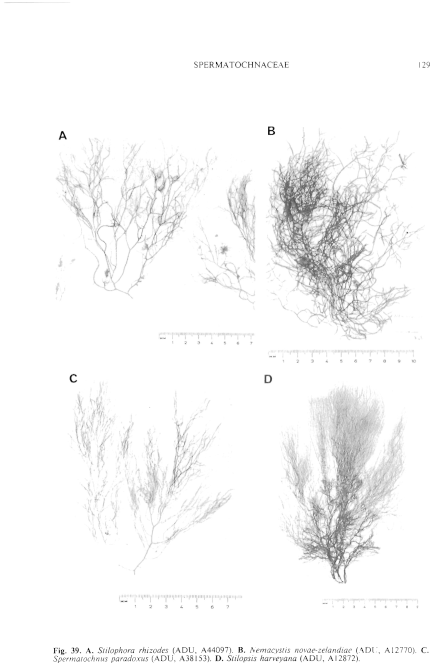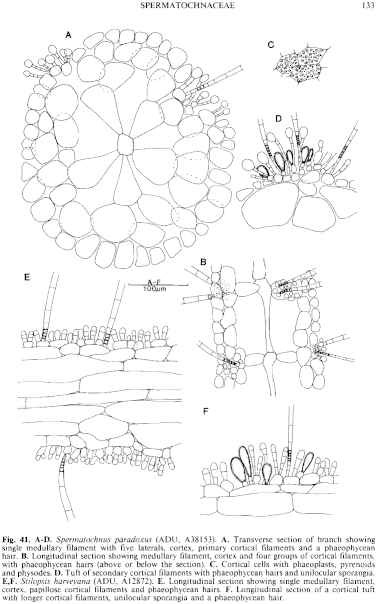|
|
|
|
|
|||||||||||
|
Electronic Flora of South Australia Species Fact Sheet
Phylum Phaeophyta – Order Chordariales – Family Spermatochnaceae
Selected citations: Hamel 1937: 182, fig. 40 (ii,ix,x). Kylin 1940: 49, fig. 27. Müller 1981: 384, figs 1–4. Oltmanns 1922: 37, fig. 333.
Synonym
Stilophora lyngbyei J. Agardh. Harvey 1849: p1.237; 1859b: 291.
Thallus (Fig. 39C) medium brown, slightly mucoid, slender, much branched in an irregularly alternate manner, 5–20 cm long with cylindrical, tapering branches 0.5–1(4.5) mm in diameter below, 100–250 in diameter near the apices, attached by a small discoid holdfast, epiphytic (?). Medulla of a single axial filament which cuts off a whorl of 4–5 laterals (Fig. 41A,B) which elongate and develop spaces between them. Cortex (Fig. 41A,B,D) (50–) 100–200 (–300) µm and (2–) 3–4 cells thick, with large inner cells grading to the smooth-surfaced outer layer of cells which are rounded to angular in surface view (Fig. 41C),15–25 µm broad and L/B 1–2 in lesser branches, becoming 30–40 (–60) µm broad and L/B 1–2 (–3) in older parts.
Primary assimilatory filaments present near the branch apices but usually not obscuring the apical cell, developed outside each lateral from the axial filament and thus forming a more or less clear whorl (Fig. 41B), each with a phaeophycean hair; secondary assimilatory filaments developing from cortical cells adjacent to the primary filaments, forming tufts which lie outside the 4 or 5 lateral cells from each axial cell and become 150–250 µm across, more or less in whorls which often become irregular by development of further tufts, with filaments 40–60 µm and 3–5 cells long, clavate, straight to slightly curved, with the terminal cell larger, subspherical, 12–16 (–18) µm in diameter and with prominent physodes; phaeophycean hairs and unilocular sporangia present in the tufts. Phaeoplasts (Fig. 41C) in outer cortical cells numerous, discoid, each with a pyrenoid, and cells with small, scattered physodes. Phaeophycean hairs 8–10 µm in diameter. Growth apical, by the single axial filament and haplostichous development from this filament.
Reproduction: Plurilocular sporangia (Sauvageau 1936, p. 123, fig. 1F,G) uniseriate, 35–50 µm and 4–8 locules long and 7–8 in diameter, not seen in Australian plants. Unilocular sporangia (Fig. 41D) usually present in secondary tufts, broadly clavate to ovoid, sessile, 20–30 µm long and 15–20 µm in diameter.
Type from the Kieler Bight, Germany; destroyed.
Selected specimens: Investigator Strait, S. Aust., 23 m, 25 m, 26 m and 33 m deep, 35° 17' 29'S, 137°17'E (Watson, 15.i.1971, 15.i.1971, 28.i.1971 and 20.i.1971; ADU, A41022, A39337, A38523 and A38552 resp., and 41 m deep, 35°24'S, 137°07'E (Watson, 14.i.1971; ADU, A38153). Blanche Harbor, Upper Spencer Gulf, S. Aust., 16 m deep (Reimers, 23.ix.1986; ADU, A57262).
Distribution: Europe and the Mediterranean.
In southern Australia, known from King George Sound, W. Aust. (Harvey 1855c, p. 536; 1863, synop. p. 12?-see below), from Investigator Strait and Blanche Harbour, Upper Spencer Gulf, S. Aust., and from Georgetown, Tas. (Harvey 1859b, p. 291).
Taxonomic notes: Microthalli (gametophytes) filamentous, with plurilocular gametangia (Papenfuss 1935, Caram 1968) producing isogametes which fuse to form the diploid sporophyte (at 20°C) or which may develop (at 9°C) without fusion into haploid macrothalli (Müller 1981).
The above collections agree well with Spermatochnus paradoxus and, as for this species from Europe, come from deep water; Harvey commented similarly for his Georgetown collection. However, Harvey's S. lyngbyei (Alg. Aust. Exsicc. 65) from King George Sound, W. Aust. was re-described by Kylin as Stilopsis harveyana, and it has not been verified that all Harvey's King George Sound collections are of the latter species. The life history has only been investigated in European plants.
Spermatochnus paradoxus is superficially very similar to Stilopsis harveyana, but has a smooth outer cortex between the secondary assimilatory tufts, in contrast to the outer cortex of short (1–2 celled) filaments in the latter.
References:
CARAM, B. (1968). Sur le reproduction du Spermatochnus paradoxus en Suêcle. C. r. Acad. Sc. Paris 266, 1828–1830.
HAMEL, G. (1937). Phéophycées de France. Fasc. III, pp. 177–240. (Paris.)
HARVEY, W.H. (1849). Phycologia Britannica. Plates 217–252. (Reeve: London.)
HARVEY, W.H. (1859b). Algae. In Hooker, J.D., The Botany of the Antarctic Voyage. Part III. Flora Tasmaniae. Vol. 2, pp. 282–343, Plates 185–196.
KÜTZING, F.T. (1845). Phycologia Germanica. (Köhne: Nordhausen.)
KYLIN, H. (1940). Die Phaeophyceenordnung Chordariales. Acta Univ. lund. N.F. Avd. 2, 36(9), 1–67, Plates 1–8.
MÜLLER, D.G. (1981). Culture studies on reproduction of Spermatochnus paradoxus (Phaeophceae, Chordariales). J. Phycol. 17, 384–389.
OLTMANNS, F. (1922). Morphologie and Biologie der Algen. Vol. 2. (Jena.)
PAPENFUSS, G.F. (1935). The development of the gametophyte of Spermatochnus paradoxus. K. Fysiogr. Sällsk. Lund. Förh. 5(20), 1–4.
SAUVAGEAU, C. (1936). Second mémoire sur les algues Phéosporées de Villefranche-sur-Mer. Bull. Stn biol. Arcachon 33, 117–204.
The Marine Benthic Flora of Southern Australia Part II complete list of references.
Publication:
Womersley, H.B.S. (14 December, 1987)
The Marine Benthic Flora of Southern Australia
Part II
©Board of the Botanic Gardens and State Herbarium, Government of South Australia
Illustrations in Womersley Part II, 1997: FIGS 39C, 41 A–D.

Figure 39 enlarge
Fig. 39. A. Stilophora rhizodes (ADU, A44097). B. Nemacystis novae-zelandiae (ADU, Al2770). C. Spermatochnus paradoxus (ADU, A38153). D. Stilopsis harveyana (ADU, Al2872).

Figure 41 enlarge
Fig. 41. A–D. Spermatochnus paradoxus (ADU, A38153). A. Transverse section of branch showing single medullary filament with five laterals, cortex, primary cortical filaments and a phaeophycean hair. B. Longitudinal section showing medullary filament, cortex and four groups of cortical filaments, with phaeophycean hairs (above or below the section). C. Cortical cells with phaeoplasts, pyrenoids and physodes. D. Tuft of secondary cortical filaments with phaeophycean hairs and unilocular sporangia. E,F. Stilopsis harveyana (ADU, Al2872). E. Longitudinal section showing single medullary filament, cortex, papillose cortical filaments and phaeophycean hairs. F. Longitudinal section of a cortical tuft with longer cortical filaments, unilocular sporangia and a phaeophycean hair.

|
Email Contact: State Herbarium of South Australia |

|